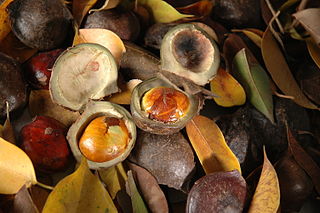
Abarema is a neotropical genus in the family Fabaceae. It is native to Brazil, Cuba, and Venezuela. Most of the species can be found in the Amazon Basin and the Guyana Highlands. They have a deep-green fernlike foliage, with bipinnately compound leaves.
Archidendron forbesii is a species of legume in the family Fabaceae. It is found only in Papua New Guinea. It is threatened by habitat loss.

Archidendron is a genus of flowering plants in the pea family, Fabaceae. It includes 98 species which range from India through Indochina, southern China, Taiwan, Malesia, and Papuasia to Queensland and New South Wales.
Archidendron oblongum is a species of legume in the family Fabaceae. It is found only in Solomon Islands.
Archidendron pahangense is a species of legume in the family Fabaceae. It is a tree endemic to Peninsular Malaysia. It is threatened by habitat loss.

Archidendron bigeminum is a tree species in the legume family (Fabaceae). It is found in India and Sri Lanka. It is known as "kalitiya - කලටිය" in Sinhala.

Archidendron pauciflorum, commonly known as djenkol, jengkol or jering is a species of flowering tree in the pea family, Fabaceae. It is native to Southeast Asia, where the seeds are a popular dish. They are mainly consumed in Indonesia, Thailand, Myanmar, and Vietnam and prepared by frying, boiling, or roasting and are also eaten raw. The beans are mildly toxic due to the presence of djenkolic acid, an amino acid which causes djenkolism. The beans and leaves of the djenkol tree are traditionally used for medicinal purposes such as purifying the blood. To date, djenkol is traded on local markets only.

Archidendron grandiflorum, the pink laceflower, is a species of tree found in northern Australia and New Guinea. This tree reaches a height of 15 meters and bears showy pink and cream colored flowers. The mature tree has a rounded habit and is used as an ornamental. This tree is also called the lace flower tree, paintbrush tree, tassel tree, and tulip siris.
As of July 2016, the International Union for Conservation of Nature (IUCN) lists 238 conservation dependent species. 0.29% of all evaluated species are listed as conservation dependent. The IUCN also lists seven subspecies and five varieties as conservation dependent.
Vitis heyneana is a species of climbing vine in the grape family endemic to Asia. It can be found in shrubby or forested areas, from almost sea-level, to 3200 meters above. It has globose berries that are purple to almost black.

Archidendron lucyi is a small tree species in the legume family (Fabaceae). The native range extends from North Eastern Australia, Eastern Malesia to the Solomon Islands. A. lucyi grows in the understorey of lowland rainforest.
Xanthophyllum subcoriaceum is a plant in the family Polygalaceae. The specific epithet subcoriaceum is from the Latin meaning "somewhat leathery", referring to the leaves.
Homalium dasyanthum is a tree or shrub in the family Salicaceae. It is found in Peninsular Malaysia, Thailand, Vietnam, Cambodia and Myanmar.






